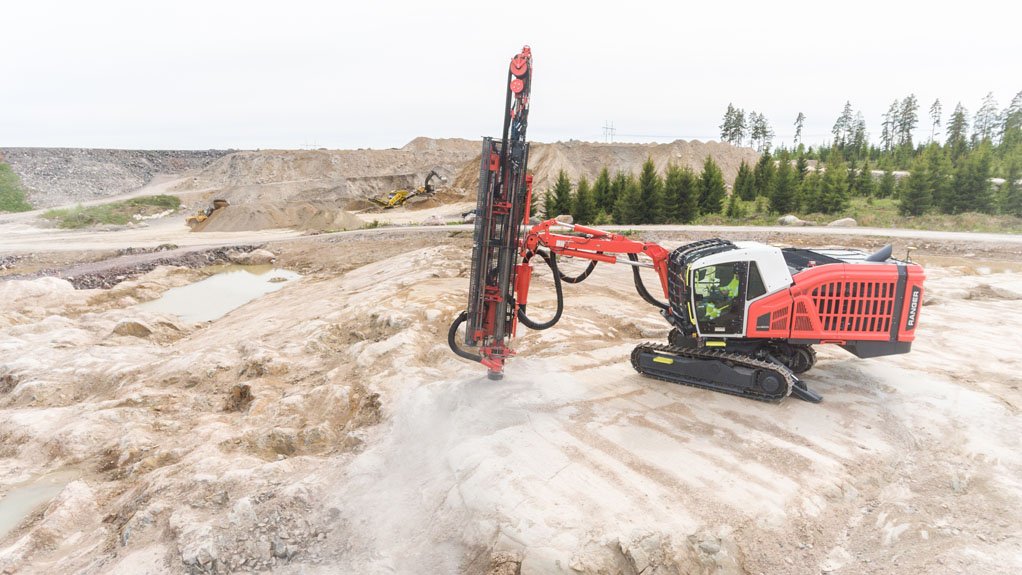Intelligence platforms have been added to Sweden-headquartered engineering company Sandvik Mining & Technology’s Ranger series of drills to allow for automation, data connectivity and improved drilling processes, increasing productivity for customers.
An example of this integration and the company’s latest answer to the evolving technological needs of the surface mining industry is the DX900i intelligent hydraulic, self-propelled, self-contained and crawler-based surface rig, launched in Finland last month and available in South Africa.
The Ranger series’ revolving superstructure, power, precision and versatility make it an ideal choice for construction, quarrying or surface mining operations, according to Sandvik.
Sandvik surface drilling and exploration president Joanne Cooke explains that the Ranger series has been around since the 1980s, but has evolved over the years, owing to customer feedback, to incorporate an intelligence platform, and technological trends.
With the Ranger DX900i, a drilling plan is created with Driller’s Office, a practical software tool for surface drilling process management, offering better drilling accuracy, hole quality and blasting results. Data is stored in the SanRemo platform and transferred wirelessly to the drill, which can then be trammed into position.
Cooke adds that the DX900i offers improved penetration rates and highly cost-effective fuel consumption.
Automatic features enable the operator to perform more drilling in each engine hour, as well as additional tasks, and allow the operator to take a short break while the machine is in automatic drilling mode. The drilling is automated with the i-torque drilling system, while hole-to-hole navigation automatics choose the next hole from the drilling pattern. The machine performs the movement and alignment automatically, and adding the rod is automated with the ‘one hole’ automation option.
The system collects all drilling data and the operator can make notes using the driller’s notes option.
Equipped with a set of RD920 series rock drills for different rock tools and hole sizes, the DX900i “will improve your drilling power, increase your productivity and reduce your costs”.
A revolving super structure of 290º allows for large drilling coverage of 55 m2. “Therefore, you don’t have to stop drilling, move the rig and place the drill again, saving time and increasing productivity,” she explains.
The rotating structure always keeps the counterweight on the opposite side of the boom. The machine is equipped with high tramming power and a low centre of gravity, providing excellent mobility, says Sandvik, while full remote control provides security when operating the machine in challenging conditions.
The new i-Cab has been designed to improve operator comfort and reduce noise levels. “Easy-to-use joysticks and control panels help the operator to stay focused and maintain daily productivity,” notes the company.
Product Development
Cooke explains that it typically takes Sandvik up to two years to develop a new product; however, the DX900i took a bit longer, owing to more extensive research and development (R&D) and testing, especially as there were critical component changes, such as the new rock drill family.
The i-series has been developed to include different rigs. The DX900i’s design is industrialised and, like other Sandvik drill rigs, “some of it is copy and paste, therefore providing a similar look and feel across the offering”, she explains.
Component testing, which formed part of Sandvik’s R&D, led to the construction of a prototype, following which preseries rigs were built to conduct further tests. This extensive testing period can take up to one year.
There is an emphasis on automated drilling, with future plans to do multihole and remote drilling, during which the operator is not in the cabin. However, the timing of implementing these innovations is heavily dependent on whether Sandvik’s customers and the drilling market are ready to adapt to a more automated approach.
“The i-series platform provides the capability to add these features when the market is ready. It is a learning curve and the main focus currently, so that we are ready for those industry trends when demand arises,” Cooke adds.
The objective of automating drilling activities for Sandvik is to monitor drilling in real time, as it enables customers to make immediate modifications and changes to drill plans. “Real time is the next step. I would say the platform to launch this feature is definitely there,” Cooke tells Mining Weekly.
Sandvik surface drills and exploration business line manager Rumisha Motilal says the company’s i-series drills are equipped with easy navigation and drilling recipes that can be altered by the operator as needed.
Owing to the changes in Sandvik’s new i-series, customers require training to operate the range’s new features. Sandvik uses simulators to train future operators, either on site or at its premises in Jet Park, Gauteng. She explains that customers using a large number of rigs can use a simulator that is set up for training on site. Different training options are offered depending on a customer’s needs.
“Simulator training is a good way of introducing customers to the layout of the cabin, so they can become familiar with the controls before handling . . . the machine. Many customers enjoy training [using] a simulator for this reason,” states Motilal.
Edited by: Tracy Hancock
Creamer Media Contributing Editor
EMAIL THIS ARTICLE SAVE THIS ARTICLE
ARTICLE ENQUIRY
To subscribe email subscriptions@creamermedia.co.za or click here
To advertise email advertising@creamermedia.co.za or click here















